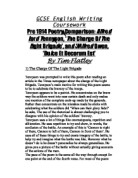A key feature of this poem is the pace. Throughout most of the poem, the pace is fairly quick. This helps the reader to imagine how quick the army was charging and the pace creates an image of explosions, gunshots and fighting. The pace is mostly quick except for a part in verse4. ‘Then they rode back, but not not the six hundred.’ The comma in this line changes the pace and slows it down. This emphasises the deaths of the soldiers and creates a slow and sad mood.
The main recurring image in this poem is the light brigade getting annihilated by the Russian firepower. The reader is always picturing an image of fighting and death.
The poem doesn’t really give an impression of being written from first hand experience. I think this because Tennyson describes the fighting in general but he doesn’t describe the soldiers up and personal. He can fairly easily describe all the guns going off but when it comes to describing the soldier’s emotions, he can’t because he wasn’t actually fighting along side them.
My response to the poem is that I wouldn’t feel bad if I died fighting like that. Tennyson writes in such a way that he makes dieing for ones country is a really brave thing to do.
Unlike The Charge of the Light Brigade, Dulce et Decorum est is written from a first hand experience. Wilfred Owen was an actual soldier, a patriot and also a pacifist. I know this because he describes the events he has witnessed and experienced, not by reading from a newspaper article.
Wilfred Owen shows throughout the poem a strong opinion against war. He describes all the pain and suffering he has witnessed and wants us back at home to think again, where as Tennyson was not against all the fighting. He just wanted to honour all the brave soldiers that fought in that war. Owen wants us to feel all the pain that he has felt. He does this by addressing and challenges the reader. ‘If you could hear, at every jolt, the blood come gargling from the froth – corrupted lungs Bitter as the cud,’ shows him addressing and trying to make the reader feel his suffering.
The title ‘dulce et decorum est (Sweet and fitting it is to die for ones country)’ is not Owen’s real point of view because at the end of the poem he says ‘ The old lie: Dulce et decorum est Pro patria mori.’ Which means that he doesn’t agree with that statement.
Compared with Tennyson’s, Owen’s poem stays at a constant, slow pace to help picture all the pain and suffering, where as Tennyson’s is quick to describe the charge. A change of pace occurs when he describes the shouts of another soldier. ‘Gas! GAS! Quick, boys!’ shows the pace getting faster and showing a scene of panic.
Throughout the poem, Wilfred Owen describes the battlefield of death, pain and suffering. He uses strong sentences and phrases to show all of his horrible experiences, unlike Tennyson who has written sentences full of excitement. Owen’s choices of words are good and strong and set a clear image. ‘He plunges at me, guttering, choking, drowning.’ In this line he used a list of 3 verbs, which describes a soldier, drowning in a mist of green gas. Another strong image is, ‘Drunk with fatigue; deaf even to the hoots of gas shells dropping softly behind.’ Here, he describes the emotional side of the soldiers and how tired they are of all the fighting.
The way that Owen writes this poem, shows that he writes from a first hand experience. Tennyson describes the battlefield and nothing else. Owen on the other hand describes the soldiers up and close, describing their feelings and emotions. He also gives more detail than Tennyson on describing the deaths of soldiers since Owen is right next to the killing. ‘Till on the haunting flares we turned out backs.’ We can tell from this that he is actually there because he includes himself in the poem (we). Being in the war, Owen gives the poem a lot of power and makes the poem strong.
My response to this poem is that war is horrible and contains so much death that to die for ones country is not the best of things but to be chucked into a cart containing a load of other dead corpses. In comparison to Tennyson’s poem where he makes you feel that there is so much bravery and honour to do and die in battle.







